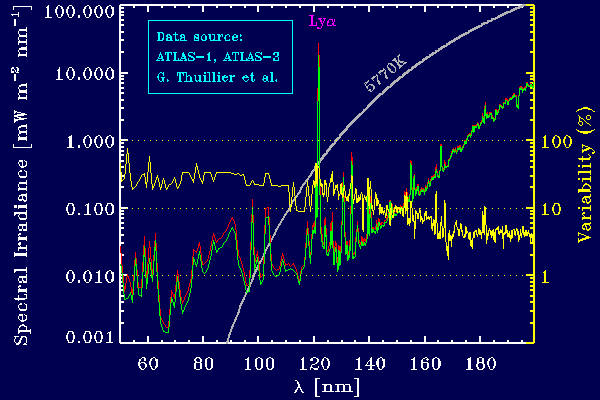Solar influences on climate


Many physical mechanism originating in the Sun can potentially affect Earth's climate, all of them being associated with the solar magntic activity cycle. The 0.1% cycle-related variations in the total solar irradiance measured from space since 1978 are too low to have had a significant effect on climate (assuming that TSI variations remained at that level in the more distant past). Another mechanism under investigation is the indirect modulation of cloud coverage via the effect of solar activity on the flux of cosmic ray entering the Earth's upper atmosphere.
Another mechanism, arguably the most
promising, invokes the large cycle-related variations of the solar
flux of ultraviolet radiation. While contributing very little to
the overall radiative energy budget, solar UV radiation is the
primary driver of heating and chemistry in the stratophere and above.
The impact
of solar activity on these atmospheric layers is now well-documented.
However, the nature of the coupling with the underlying tropospheric
layers (0 to 10 km in altitude) remains poorly understood.

Figure 1: A portion of the solar spectrum in the far ultraviolet. The yellow line indicates the general level of variability betwen high and low and activity phases. Note however than for certain spectral lines, such as Lyman-alpha of CaH+K, the variability can be larger by over an order of magnitude. Data from the Atlas-1 mission, courtesy of G. Thuillier (Service d'Aéronomie/CNRS, France).
The first component of this project centers on the development
of a physical model for the changes of the solar UV flux associated
with varying overall activity levels, with emphasis on the spectral
bands important for stratospheric dynamics and chemistry.
We plan to feed the output of our
dynamo models of the solar activity cycle
to a extension of our current
model of the total solar irradiance,
modified to produce time series of UV radiative fluxes in the
spectral bands of interest. This will require the parallel development
of improved models for the formation of faculae and supergranular
magnetic network, for which our recently developped
DLA model of supergranulation
offers an excellent starting point. Knowing the photospheric
coverage of these various classes of UV-emitting photospheric structures,
the final step will be to construct global UV spectra using extant
empirical spectral data.
This project is partly supported by a
research grant
from the program "projets de recherche en équipe" of
FQRNT (Québec).
Who in the group works on this:
Paul Charbonneau,
Kim Thibault,
Cassandra Bolduc, in collaboration with
Michel Bourqui (Dept. of atmospheric and oceanic sciences, McGill U.),
and Stella Melo (Canadian Space Agency).
Climate response
The climate's response to variations in the solar UV flux
occurs most likely through ozone, the primary UV absorber
in the stratosphere. The key question, targeted in the
second component of the project, is the nature and efficiency
of the coupling between the stratosphere and upper troposphere.
This coupling is highly dynamical (exchange of air masses,
turbulent mixing, etc), and so its modelling requires a
coupled climate+chemistry model. The first step will be to
use the model FASTOC, a very computationally efficient model
of chemistry and (reduced) atmospheric dynamics, for a systematic
investigation of tropospheric response to varying solar activity levels,
through a large set of simulations on timescales spanning
years to centuries. The idea here is to produce ensemble averages
that are statistically meaningful. This will be complemented
by more focused, physically complex simulations using the
Canadian Middle Atmosphere Model (CMAM).
|
Dernières modifications le 1 novembre 2007 par
paulchar@astro.umontreal.ca.
|
|